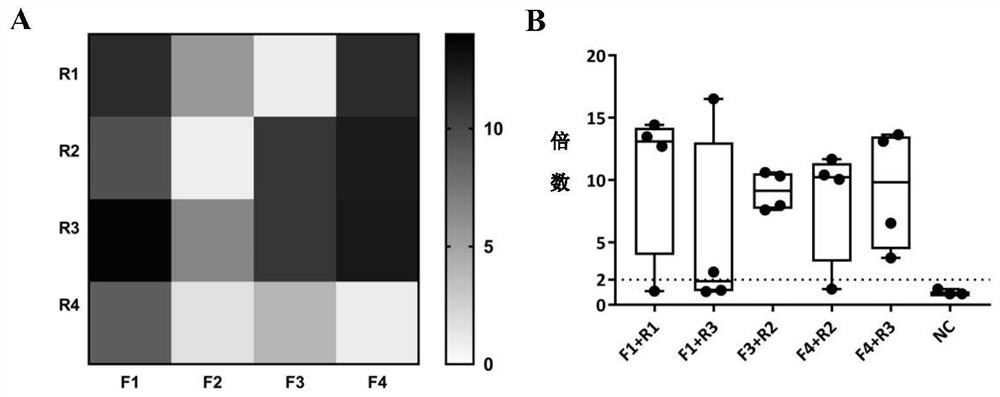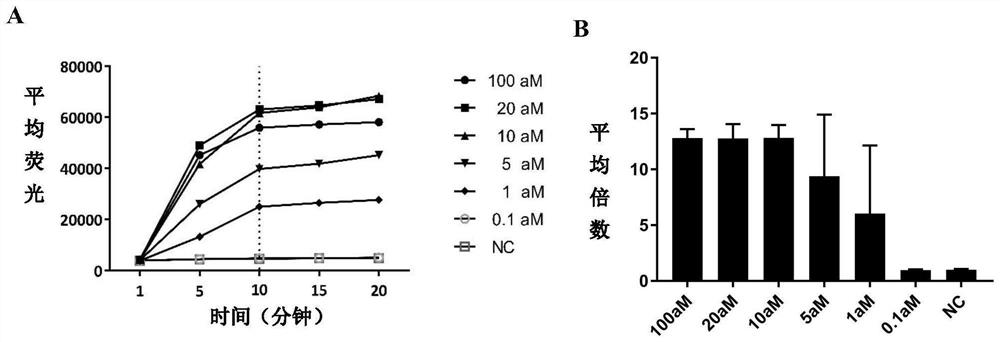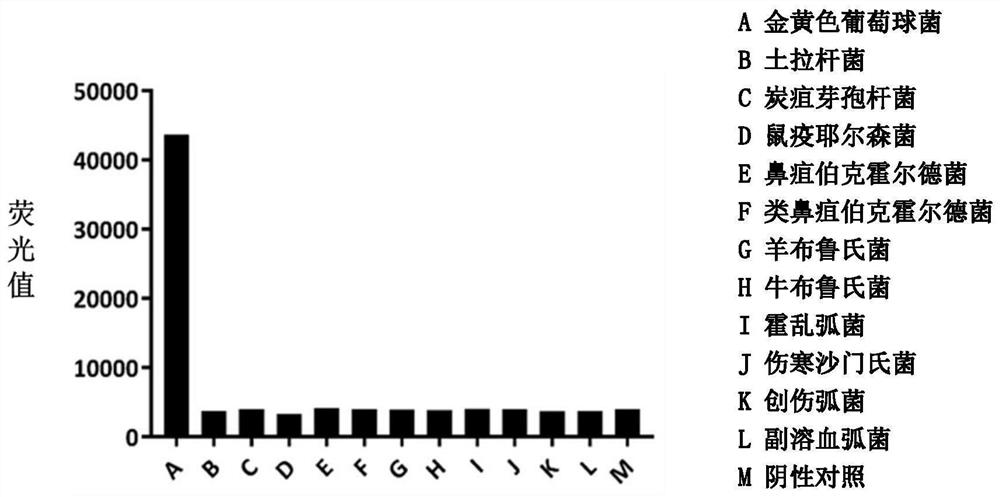Detection method of Staphylococcus aureus based on exo-rpa technology and its complete set of reagents
A staphylococcus, golden yellow technology, applied in the biological field, can solve the problems of low sensitivity and short amplification reaction time, achieve high sensitivity, get rid of the dependence of precision instruments, and good specificity
- Summary
- Abstract
- Description
- Claims
- Application Information
AI Technical Summary
Problems solved by technology
Method used
Image
Examples
Embodiment 1
[0041] Embodiment 1, the construction of Staphylococcus aureus exo-RPA detection method
[0042] The design of the sequence.
[0043] 1. Target sequence selection.
[0044] On the basis of previous research, the present invention selects the chromosomal specific sequence femB of Staphylococcus aureus (sequence shown in SEQ ID No. 1) as the target sequence after repeated screening and comparison, which can specifically detect Staphylococcus aureus. .
[0045] 2. Design of RPA amplification primer pair and RPA probe.
[0046] According to the above-mentioned chromosomal-specific gene femB sequence of Staphylococcus aureus, multiple RPA amplification primer pairs and RPA probes were designed: RPA-femB-F1, RPA-femB-F2, RPA-femB-F3, RPA-femB-F4, RPA -femB-R1, RPA-femB-R2, RPA-femB-R3, RPA-femB-R4 and RPA-femB-P. The specific sequence is shown in the following table:
[0047] Table 1 Candidate RPA amplification primer pairs and paired fluorescent probes of the present invention...
Embodiment 2
[0063] Example 2. Sensitivity and specificity evaluation of Staphylococcus aureus exo-RPA detection method
[0064] 1. Genome sensitivity and stability analysis
[0065] The detection was carried out according to the "three, Staphylococcus aureus exo-RPA detection method" in Example 1, and the template DNA was the concentration gradient of Staphylococcus aureus genomic DNA 100aM, 20aM, 10aM, 5aM, 1aM, 0.1aM, a total of 6 gradients, 2μL ddH 2 O was used as a negative control, and the sensitivity and stability were evaluated by 7 repeated experiments.
[0066] The result is as figure 2 As shown in A, take the average fluorescence value of the reaction time of 1 minute, 5 minutes, 10 minutes, 15 minutes and 20 minutes respectively, and the positive detection time of the reaction is 5-10 minutes; figure 2 B shows that the detection sensitivity of S. aureus genomic DNA can reach 1 aM, and the experimental repeatability is good, indicating that the detection method has high sens...
Embodiment 3
[0070] Example 3. Application of the method of the present invention in the detection of Staphylococcus aureus nucleic acid in simulated clinical samples
[0071] In order to verify the practicability of the exo-RPA detection method of Staphylococcus aureus, Staphylococcus aureus (USA300) was added to normal human whole blood with different numbers, respectively, and the samples containing 10 3 -10 1The whole blood of Staphylococcus aureus at the concentration of CFU / mL, and the same volume of PBS was added to the group was the blank control sample (BC group). Nucleic acids from whole blood mock samples were extracted with QIAamp DNA Mini Kit. The testing personnel performed blind testing on the above 12 samples: 3 μL of the extracted nucleic acid from the above samples was taken as a template, and the specific gene nuc of the samples was detected by real-time fluorescent PCR (COPPENS J, VAN HEIRSTRAETEN L, RUZIN A, et al. .Comparison of GeneXpert MRSA / SA ETA assay with semi...
PUM
 Login to View More
Login to View More Abstract
Description
Claims
Application Information
 Login to View More
Login to View More - R&D
- Intellectual Property
- Life Sciences
- Materials
- Tech Scout
- Unparalleled Data Quality
- Higher Quality Content
- 60% Fewer Hallucinations
Browse by: Latest US Patents, China's latest patents, Technical Efficacy Thesaurus, Application Domain, Technology Topic, Popular Technical Reports.
© 2025 PatSnap. All rights reserved.Legal|Privacy policy|Modern Slavery Act Transparency Statement|Sitemap|About US| Contact US: help@patsnap.com



